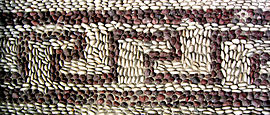
A meander or meandros[1] (Greek: Μαανδρος) is a decorative border constructed from a continuous line, shaped into a repeated motif. Such a design is also called the Greek fret or Greek key design, although these are modern designations.
On the one hand, the name "meander" recalls the twisting and turning path of the Maeander River in Asia Minor, and on the other hand, as Karl Kerenyi pointed out, "the meander is the figure of a labyrinth in linear form".[2] Among some Italians, these patterns are known as Greek Lines. Usually the term is used for motifs with straight lines and right angles; the many versions with rounded shapes are called running scrolls.
Meanders are common decorative elements in Greek and Roman art. In ancient Greece they appear in many architectural friezes, and in bands on the pottery of ancient Greece from the Geometric Period onwards. The design is common to the present-day in classicizing architecture. The meander is a fundamental design motif in regions far from a Hellenic orbit: labyrinthine meanders ("thunder" pattern[3]) appear in bands and as infill on Shang bronzes, and many traditional buildings in and around China still bear geometric designs almost identical to meanders. There is a possibility that meanders of Greek origin may have come to China during to the time of the Han Dynasty by way of trade with the Greco-Bactrian Kingdom.
They were among the most important symbols in ancient Greece; and perhaps symbolized infinity and unity; many ancient Greek temples incorporated the sign of the meander. Greek vases, especially during their Geometric Period, were probably the main reason for the widespread use of meanders; alternatively, very ocean-like patterns of waves also appeared in the same format as meanders, which can also be thought of as the guilloche pattern. The shield of Philip II of Macedon, conserved in the museum of Vergina, is decorated with multiple symbols of the meander. Meanders are also prevalent on the pavement mosaics found in Roman villas throughout the Roman empire. A good example is at the Chedworth Roman Villa in England, leading many[who?] historians to believe that the pattern was part of the original inspiration for the Latin "G" character.[citation needed]
Meanders and their generalizations are used with increasing frequency in various domains of contemporary art. The painter Yang Liu, for example, has incorporated smooth versions of the traditional Greek Key (also called Sona drawing, Sand drawing, and Kolam) in many of her paintings. (Source: Wikipedia)

